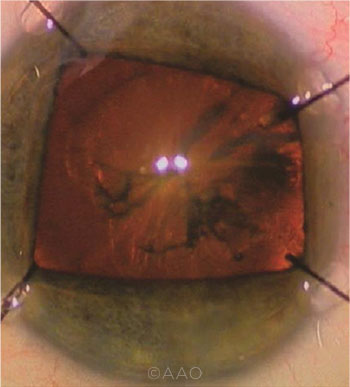Download PDF
An analysis of causes and outcomes of malpractice litigation among patients with glaucoma suggests that risk to both patients and providers can be reduced by conducting careful examinations and documenting detailed conversations with patients.1 The analysis revealed that nearly 40% of cases involved allegations of mismanagement or failure to diagnose and treat. Adverse drug effects and surgical complications also resulted in litigation.
“Our study confirms much of what has been reported, and it reinforces the need for risk management to be a part of clinical care,” said Ashvini K. Reddy, MD, in private practice in San Antonio, Texas.
 |
COMMON MISTAKES. Nearly 25% of the claims involved either angle-closure glaucoma (shown here) or open-angle disease.
|
Disproportionately high awards. The researchers identified 69 glaucoma malpractice cases in the WestLaw database occurring between 1962 (the first year in which cases were reported) and 2014. Well over half (62.3%) resolved in favor of defendants. Eight jury verdicts awarded a mean of $994,260 to plaintiffs, while 10 cases settled with a mean indemnity of $1.2 million. (Amounts were adjusted for inflation in 2015 dollars.)
Although the rate of glaucoma plaintiff verdicts mirrored ophthalmology overall, median awards were 1.7 times higher than the whole—$977,474 in glaucoma versus $604,352 for all of ophthalmology.
Common scenarios. Of the 69 cases, 35 (50.7%) involved allegations of insufficient intervention, such as failure to diagnose or treat, and failure to monitor properly through intraocular pressure (IOP) checks, dilated examinations, and visual field (VF) testing. Thirteen cases (18.8%) involved failure to diagnose or treat and/or mismanagement of angle-closure glaucoma, and 12 cases (17.4%) involved failure to diagnose open-angle glaucoma. Of 10 varied surgical and procedural claims, six involved trabeculectomy.
An unexpected finding. While adverse effects of glaucoma medications were not common (10; 14.5%), the median award value of nearly $1 million was a surprise, Dr. Reddy said. All but two of 10 cases involving topical glaucoma medication resulted in payments, including a $1.3 million settlement for an elderly woman with a known history of asthma who sustained permanent brain damage after being administered timolol.
Examine, talk, document. Challenges inherent to glaucoma—such as its chronicity and the ongoing need to revise disease management—may explain the disproportionately high awards, the researchers noted. They advised routine IOP measurements, visual field testing, and dilated exams for all glaucoma suspects.
Dr. Reddy stressed the importance of communication, especially with patients who have aggressive disease, guarded prognoses, or poor outcomes. “These patients are particularly high risk and need to be very involved in decisions. Documentation of their involvement is also important.”
—Miriam Karmel
___________________________
1 Engelhard SB et al. Ophthalmol Glaucoma. 2021;4(4): in press.
___________________________
Relevant financial disclosures—Dr. Reddy: Alimera: C; Clearside: C; Eyepoint: C; Heidelberg: C.
For full disclosures and the disclosure key, see below.
Full Financial Disclosures
Dr. Ensign Co-inventor on patent applications describing the suture technology; Robert H. Smith Family Foundation: S; Research to Prevent Blindness: S; National Institutes of Health: S; National Science Foundation: S.
Dr. Hedges None.
Dr. Kokame Allergan: C; Bayer: C,L; Bausch + Lomb: C,L; Carl Zeiss: C,L; Genentech: C,S; Novartis: S; Regeneron: C,L,S; RegenxBio: S; Salutaris: S.
Dr. Reddy Alimera: C; Clearside: C; Eyepoint: C; Heidelberg: C.
Disclosure Category
|
Code
|
Description
|
| Consultant/Advisor |
C |
Consultant fee, paid advisory boards, or fees for attending a meeting. |
| Employee |
E |
Employed by a commercial company. |
| Speakers bureau |
L |
Lecture fees or honoraria, travel fees or reimbursements when speaking at the invitation of a commercial company. |
| Equity owner |
O |
Equity ownership/stock options in publicly or privately traded firms, excluding mutual funds. |
| Patents/Royalty |
P |
Patents and/or royalties for intellectual property. |
| Grant support |
S |
Grant support or other financial support to the investigator from all sources, including research support from government agencies (e.g., NIH), foundations, device manufacturers, and/or pharmaceutical companies. |
|
More from this month’s News in Review